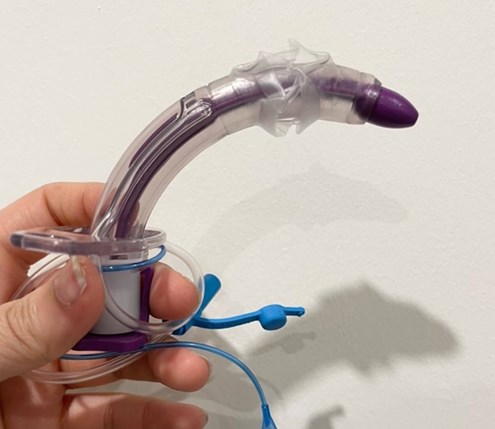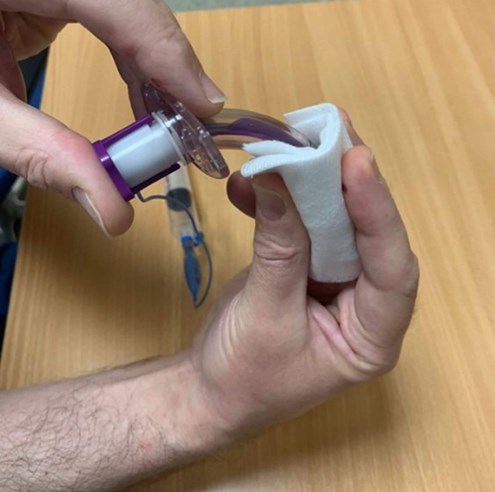
In this article, the authors describe a quick and effective technique to assist with the maximal deflation of a tracheostomy tube cuff prior to insertion, thus making the process easier with less chance of damage to the cuff and a smoother insertion of the tube.
The accurate placement of cuffed tracheostomy tube into the airway is a key step in airway management. Before inserting a tracheostomy tube, the cuff is checked to ensure the tube is functional and there is no air leak present. In our experience, the majority of tubes have a deflated cuff that does not sit flush to the tube.
Folds often form in the balloon cuff when deflated, creating an uneven surface area of contact and an unnecessary increase in the size of the cuff, resulting in additional friction when inserting the tube into a newly formed stoma (Figure 1). This has the potential to increase the risk of cuff rupture, particularly in patients with calcified tracheas, necessitating tube replacement. Moreover, iatrogenic tracheal injury such as posterior tracheal wall laceration or perforation can occur from using excessive physical force when inserting a tracheostomy tube [1].


Figure 1. Formation of folds in the balloon cuff when deflated, note how the cuff does not sit flush to the tube.
We describe the ‘umbrella furling’ technique for deflating the cuff of a tracheostomy tube. It is a simple approach that enables the deflated cuff to sit flush to the tube, therefore allowing an easier ‘reduced-friction’ insertion of a cuffed tracheostomy tube into a newly created stoma. The same technique can be used to facilitate the insertion of endotracheal tubes through an enclosed laryngoscope.

Figure 2. A damp swab is used to flatten the cuff between the index, middle, ring fingers, and thumb.
Whilst rotating the tracheostomy tube in a slow continuous movement,
the assistant is asked to simultaneously slowly deflate the balloon cuff.


Figure 3. After the ‘umbrella furling’ technique, the deflated balloon cuff should sit flush against the tracheostomy tube.
Method
The ‘umbrella furling’ deflation technique for cuffed tracheostomy is ideally a two-person technique. The steps are as follow:
- A 20ml syringe is securely attached to the adaptor at the end of the pilot balloon to inflate the tracheostomy tube balloon cuff.
- A damp gauze swab is used to wrap around the inflated cuff of the tracheostomy tube in between the index, middle, ring fingers, and thumb of the dominant hand (Figure 2).
- An assistant is asked to slowly deflate the cuff. Simultaneously, using the non-dominant hand, the tracheostomy tube is slowly rotated whilst maintaining gentle pressure on the cuff.
- Once the tube itself is felt through the balloon cuff, the cuff is fully deflated, and the syringe removed.
- The cuff should now lie flush against the tracheostomy tube (Figure 3).
Discussion
Cuffed tracheostomy tubes are frequently used in the postoperative period to reduce the risk of blood or mucus entering the lungs. They are characterised by a soft balloon at the distal end of the tube which inflates to create a tight seal between the tube and trachea. Cuffed tubes are also necessary to deliver positive pressure ventilation, or when airway protection is required to prevent aspiration of oropharyngeal secretions or gastric fluid.Often, the deflated cuff does not sit flush to the tube due to the formation of folds in the balloon cuff when deflated. The ‘umbrella furling’ deflation technique reduces the creation of these folds allowing the deflated cuff to sit flush to the tube. Therefore, it facilitates an easier cuffed tracheostomy tube insertion, reducing the risk of cuff rupture, especially when encountering the ragged calcified tracheal cartilage.

Figure 4. Demonstrating endotracheal intubation through an enclosed laryngoscope.
This technique can be also used for cuffed tracheostomy tube changes or to prepare laryngeal and endotracheal balloon cuffs. The ‘umbrella furling’ technique is particularly useful when passing an endotracheal tube down an enclosed laryngoscope through a small lumen (Figure 4). In our experience, it also enables the use of the largest-fitting tracheostomy tube, often preferred in newly formed tracheostomy to allow the stoma to mature. Tubes of smaller diameters can be used thereafter.
“The ‘umbrella furling’ deflation technique reduces the creation of these folds allowing the deflated cuff to sit flush to the tube”
Additionally, having a cuff that sits flush to the tube reduces the resistance met when inserting the tracheostomy tube. Subsequently, the magnitude of the force required to insert the tracheostomy tube is less, reducing the risk of any tracheal trauma such as laceration or perforation of the posterior wall of the trachea (1, 2). The purpose of using a swab soaked in saline is to reduce the friction between the swab and the cuff while rotating it, subsequently reducing the risk of cuff rupture.
KEY POINTS
-
When deflated, folds often form in the balloon cuff of a tracheostomy tube resulting in additional friction when inserting the tube.
-
Furthermore, this potentially increases the risk of cuff rupture, particularly in patients with calcified tracheas and iatrogenic tracheal injury from using excessive physical force when inserting a tracheostomy tube.
-
The umbrella furling technique for deflating the cuff of a tracheostomy tube is a simple approach whereby the cuff is slowly deflated with a damp gauze wrapped around it while simultaneously twisting the tracheostomy tube.
-
This enables the deflated cuff to sit flush to the tube, therefore allowing an easier ‘reduced-friction’ insertion of a cuffed tracheostomy tube and reducing the risk of damage to the cuff.
-
The same technique can be used to facilitate the insertion of endotracheal tubes through an enclosed laryngoscope.
References
1. Jacobs JR, Thawley SE, Abata R, et al. Posterior tracheal laceration: A rare complication of tracheostomy. Laryngoscope 1978;88(12):1942-6.
2. Okada S, Ishimori S, Yamagata S, et al. Videobronchoscope-assisted repair of the membranous tracheal laceration during insertion of a tracheostomy tube after tracheostomy. J Thorac Cardiovasc Surg 2002;124(4):837-8.
Acknowledgement
A special thanks to Elaine Muir, Head and Neck Specialist Nurse at Ninewells Hospital who narrated the video.
Click the image below to watch:
The ‘umbrella furling’ deflation technique for cuffed tracheostomy tube
- a useful tip for an easier tracheostomy insertion.
Declaration of competing interests: None declared.









